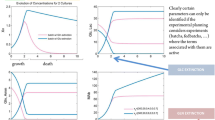Abstract
Animal cell cultures are characterized by very complex nonlinear behaviors, difficult to simulate by analytical modeling. Artificial Neural Networks, while being black box models, possess learning and generalizing capacities that could lead to better results. We first trained a three-layer perceptron to simulate the kinetics of five important parameters (biomass, lactate, glucose, glutamine and ammonia concentrations) for a series of CHO K1(Chinese Hamster Ovary, type K1) batch cultures. We then tried to use the same trained model to simulate the behavior of recombinant CHO TF70R. This was achieved, but necessitated to synchronize the time-scales of the two cell lines to compensate for their different specific growth rates.
Similar content being viewed by others
References
Bastin G & Dochain D (1990) On Line Monitoring and Adaptive Control of Bioreactors. Elsevier, New York.
Chotteau V, Fabry L, Lowagie L & Wérenne J (1991) Biomass estimation in anchorage dependent animal cell culture. In: Spier RE, Griffith JB and Maignier B (eds.) Production of Biologicals from Animal Cell Culture (pp. 580–585) Butterworth Heinemann, Oxford.
Chotteau V, Bastin G, Wérenne J & Fabry L (1992) Experimental validation of reaction mechanism for a class M animal cell culture. In: Spier RE, Griffith JB and Mc Donald C (eds.) Animal cell technology: Developments, Processes and Products (pp. 292–297) Butterworth Heinemann, Oxford.
di Massimo C, Montague GA, Willis MJ, Tham MT & Morris AJ (1992) Towards improved penicilin fermentation via artificial neural networks. Comp Chem Eng 16(4): 283–291.
Graefe J, Bogaerts P, Castillo J, Cherlet M, Wérenne J, Marenbach P & Hanus R (1999) A new training method for hybrid models of bioprocesses. Bioprocess Engineering 21: 423–429.
Hanomolo A, Bogaerts Ph, Graefe J, Cherlet M, Wérenne J & Hanus R (2000) Maximum likelihood parameter estimation of a hybrid neural-classic structure for the simulation of bioprocesses. Mathematics and Computers in Simulation 51: 375–385.
Schalkoff RJ (1997) Artificial Neural Networks. McGraw-Hill, New York.
Tholudur A & Ramirez WF (1996) Optimization of fed-batch bioreactors using neural network parameter function model. Biotechnol Prog 12: 302–309.
Willis MJ, Montague JA, Di Massimo C, Tham MT & Morris AJ (1992) Artificial neural networks in process estimation and control. Automatica 28: 1181–1187.
Zhang BS, Tang R, Leigh JR, Dixon K & Hinge RD (1996) Improved quality and productivity in secondary metabolite fermentation through estimation, control and scheduling. In: Proceedings IFAC, the 13th Triennal World Congress, (pp. 437–442), San Francisco, USA.
Author information
Authors and Affiliations
Corresponding author
Rights and permissions
About this article
Cite this article
Marique, T., Cherlet, M., Hendrick, V. et al. A general artificial neural network for the modelization of culture kinetics of different CHO strains. Cytotechnology 36, 55–60 (2001). https://doi.org/10.1023/A:1014084802708
Issue Date:
DOI: https://doi.org/10.1023/A:1014084802708




